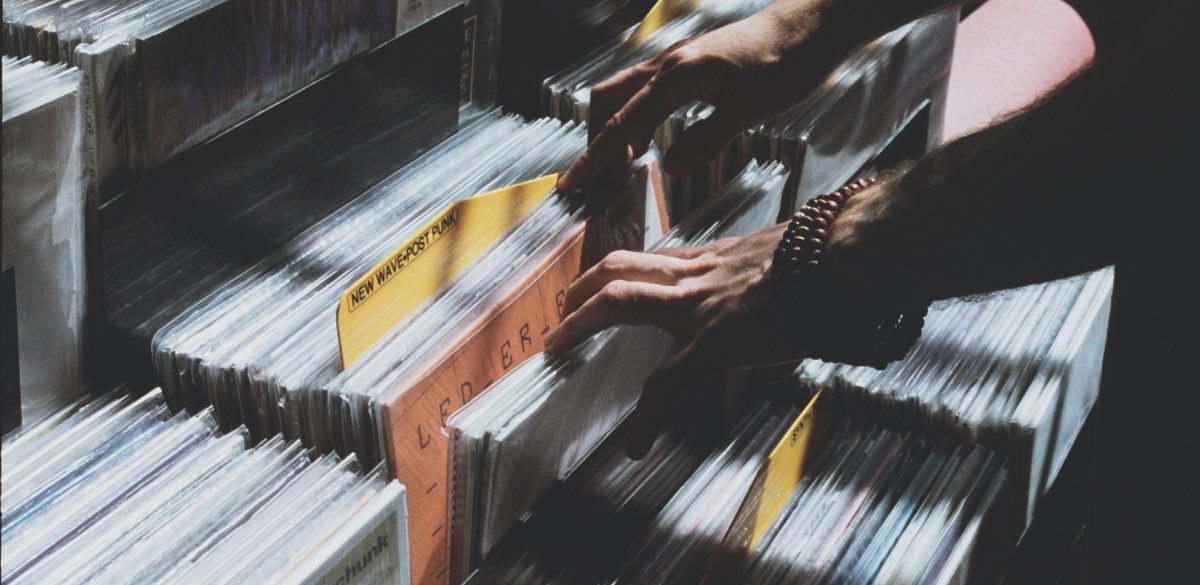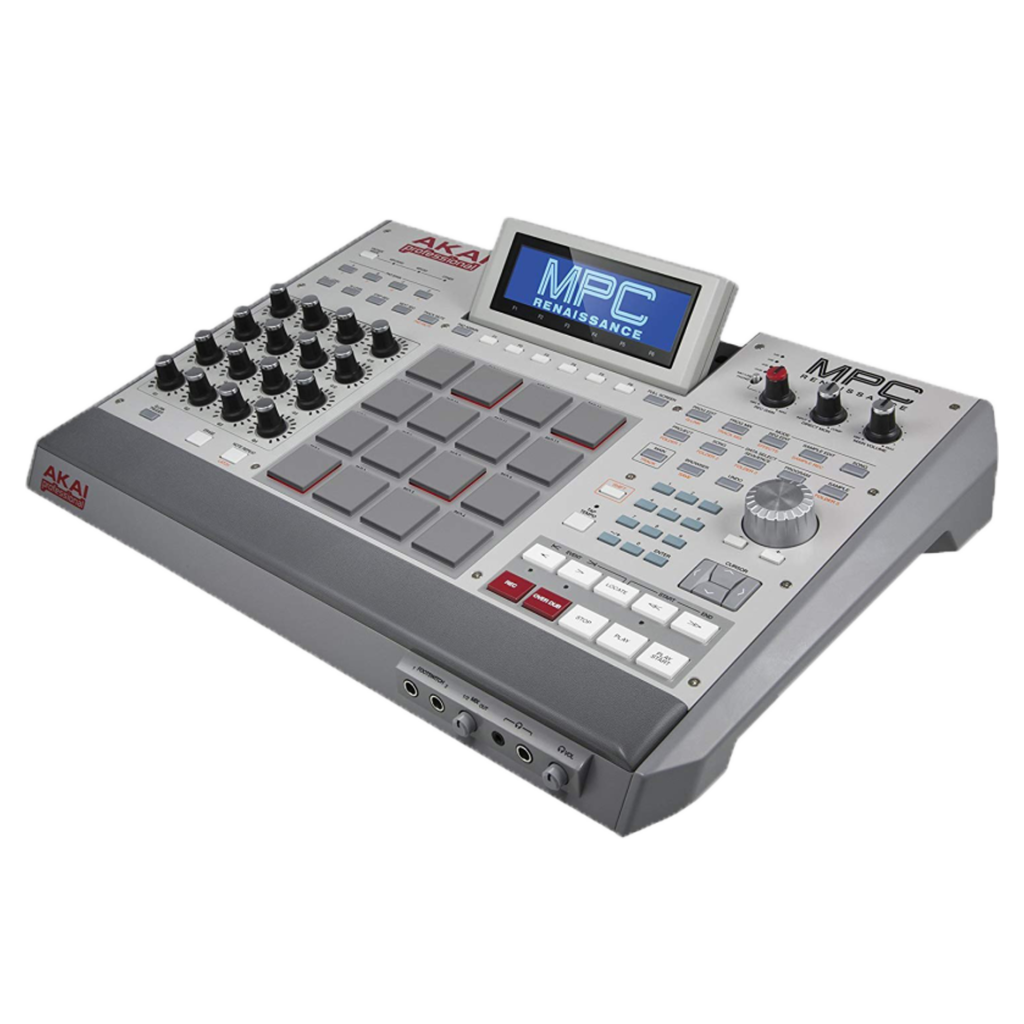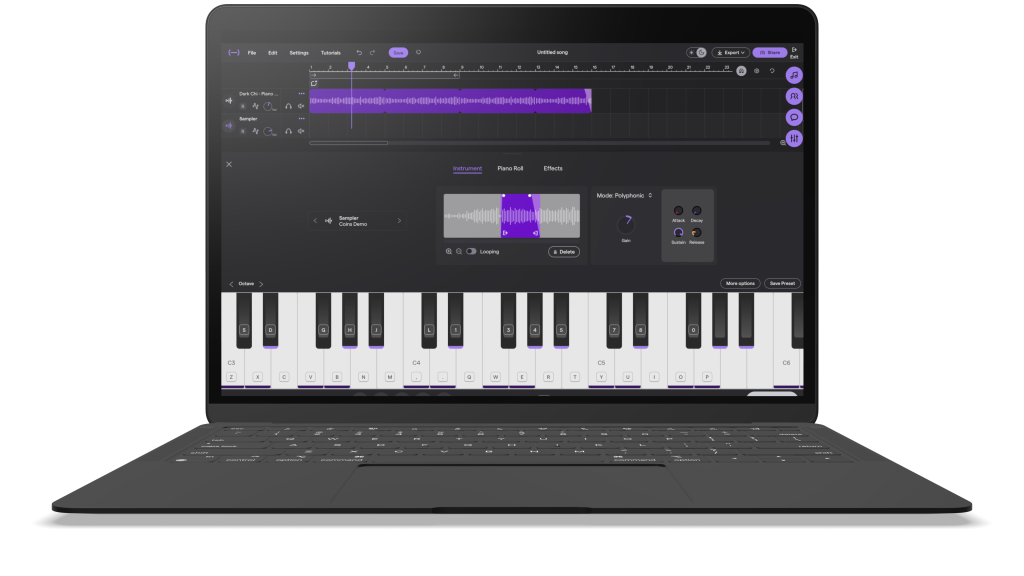
The Sampler — A Guide to Sampling in Music
Mar 29, 2023
-
Anton Berner
Music sampling has been around for decades, giving musicians the power to manipulate sounds in exciting and innovative ways. But what is a sampler? And how can you use it to make great music? Continue reading to find out!
Music sampling has been around for decades, giving musicians the power to manipulate sounds in exciting and innovative ways. But what is a sampler? And how can you use it to make great music?
This blog post will answer these questions and more, offering an overview of the history of music sampling, an exploration of the different types of samplers available, plus tips on how to get started with your own sampler, and how to get the most out of it.
So if you’re interested in learning about music sampling or already have some experience and are looking for ways to improve your workflow, then this blog post is for you. Once you feel ready to get started, be sure to try out The Sampler by Soundtrap – a powerful tool designed to help music producers turn samples into high-quality instruments quickly and easily.
What is a Sampler?
A sampler is a digital device or program that can capture, store, and play back audio samples. The device has been around for decades and has become an essential part of creating music in various genres, predominantly hip-hop, house, and techno. Samplers are used to create unique sounds from audio sources by manipulating the sound waves and blending them with other samples or instruments to create something new.
Samplers are commonly used to transform a sound into a new instrument. Music producers can, for example, sample a drum sound or a guitar note from an old recording — called a one-shot. This sampled one-shot can then be tweaked and manipulated inside the sampler and used to build a drum pattern or melody for a brand-new song.
Samplers are also often used to capture entire instrumental and/or vocal snippets from other recordings and reused over a new production — called loop sampling. This is very common in Hip Hop and Electronic music where producers will sample one or more bars of older recordings and loop that sample over a new drum beat and bassline.

Hardware vs. Software samplers
The most common types of samplers are hardware samplers and software samplers. A hardware sampler is a physical device that allows users to capture audio samples from other sound sources such as vinyl records and CDs. One of the earliest and perhaps most known digital hardware samplers was the AKAI MPC60 (1988).
Software samplers are digital programs that allow users to create and manipulate audio samples using their computer or mobile device. You simply import your audio file into your DAW software and program the sample using a digital plugin. Most DAWs (Digital Audio Workstations) offer some variation of a sampler instrument in the interface.
Soundtrap’s online studio has a powerful but easy-to-use sampler, ready to start using in your browser without having to download anything to your computer.
How to use the Soundtrap Sampler
The history of music sampling
Music sampling has been at the forefront of music production for decades. It first emerged as a tool of electronic music in the 1960s, when musicians used tape replay keyboards, which store recordings on analog tape. The Mellotron was one of the first notable models to be used widely by music groups in the late 60s and 70s.
The 1970s saw samplers become digital instruments, allowing for more complex compositions to be created from existing recordings. The first commercially available sampling synthesizer was the Computer Music Melodian in 1976. The digital samplers made the process of sampling less troublesome since they didn’t require analog tape recorders. Now, any sound could be imported from vinyl and converted to digital audio inside the sampler.
Some of the early commercial use of sampling in music first appeared on albums like Kraftwerk’s ‘Trans Europe Express’ (1977). By the 1980s, sampling became hugely popular with hip-hop artists who would use sections from existing songs and loop them into their own creations. It became widely popular in hip-hop to sample the drum breaks from funk records, which gave early rappers a hard and consistent drum beat to rap over.

With digital samplers, any sound could be imported from vinyl and converted to digital audio.
The industry standard for hip hop sampling was the AKAI MPC60, released in 1988, a digital sampler that came to be the most important instrument in early hip hop and rap. Many hip hop producers still use the AKAI MPC to this day and it continues to play an important role in sample-based beat making.
Today, samples are not only used to create original sounds but also for remixing existing tracks or creating mashups. Thanks to the emergence of software samplers in the 90s and 00s,, anyone can start using samples in their productions with ease; there’s now a wide range of options available on the market, so you’re sure to find one that suits your needs and experience level! Sampling continues to be an influential force in modern music production, far beyond hip-hop and rap; as it allows producers to mix different elements together and craft something fresh and new out of them.
Today, many sample-based producers use the availability of premade loops and samples online. Soundtrap, Splice, and Tracklib are just a few examples of online libraries where hobbyists and professionals can find samples and sounds to flip over their productions.
Examples of producers using sampling in their music
In the realm of music production, some of the most iconic producers in history have employed sampling. From the Beastie Boys’ eclectic array of samples by Rick Rubin, to DJ Shadow’s pioneering use of sampling, to J Dilla’s deconstruction and manipulation of jazz, funk and soul to create the now very popular genre: LoFi Hip Hop.
Prodigy’s Liam Hawlett’s use of multiple song samples to stitch together Smack My Bi*** Up is nothing less than mindblowing. Avicii’s sampling of Etta James’ voice on Levels. Kanye West’s sped up chops of vocals samples started a new era in hip-hop in the early 00s. Daft Punk’s Harder, Stronger, Better turned old funk grooves into modern dance music. Madlib’s genre-defying combinations, and Gramatik’s blending of classic rock and jazz records with modern production techniques. DJ Premier should also be noted for his ability to chop up samples from various records and combine into a signature sound of beats. Each of these producers has used sampling to create their own signature sound.
Check out these incredible examples of sample-based hit songs, provided by the online sample library Tracklib.
Sample Breakdown: The Chemical Brothers – Block Rockin’ Beats
Sample Breakdown: J. Dilla – Don’t Cry
The different types of samplers
Sampling in music production is again becoming increasingly popular. We’re seeing samplers being used in more modern genres of hip-hop like Drill and Trap, as well as pop, EDM and neo-soul. With a wide variety of samplers available, it’s important to understand the different types and how they each work.
Hardware Samplers
Hardware samplers are physical devices that contain onboard memory and allow users to store and manipulate sound samples. They usually include knobs and buttons for creating beats, as well as a sound library for easy access to sounds.
Software Samplers
Software samplers, on the other hand, are digital programs that allow users to work with sound samples on their computers. These may come preinstalled with DAWs (Digital Audio Workstations) or be available as third-party plugins or stand-alone applications. In Soundtrap, The Sampler lets you import any sampled sound or instrument and create your own unique sound from it. Read more about The Sampler here.
MIDI Samplers
MIDI (Musical Instrument Digital Interface) samplers are also becoming more common in music production. These allow producers to connect MIDI instruments such as keyboards, drum pads, or drum machines to their computers via USB or Firewire cables. This type of sampler can be used to create virtual instruments and sequences which can then be manipulated using the MIDI controller device connected to the computer.
Virtual Samplers
Virtual samplers are software versions of hardware ones; they replicate many of the same features found in hardware units but cost significantly less money. Analog samplers use analog circuitry instead of digital signals; these offer an entirely different kind of sound compared to digital ones due to their warm tone and ‘vintage’ character.
Make sure to find out what you’re looking for before you decide on which type of sampler to invest in and do your research. And if you’re unsure, you can always try out Soundtrap’s sampler for free before signing up for a subscription or purchasing any hardware.
The benefits of using a sampler in music production
Using a sampler in music production offers many advantages over traditional instruments. For starters, it can provide access to sounds and effects that simply aren’t available with traditional instruments. Samplers can be used to create unique soundscapes and textures by layering multiple sounds without having to record each element separately. This can save time and add variety and depth to your compositions.
A sampler also gives the producer an arsenal of all the instruments and sounds in the world, in one device. During the early days of hip-hop, artists came from the poor neighborhoods of the Bronx and Brooklyn, where expensive live instruments were a mere dream to afford. The sampler allowed these hip-hop DJs and producers to create music by repurposing old funk records into a revolutionary new sound.
Sampling also allows producers to easily access a wide range of samples from different sources, such as vinyl records, CDs, mp3s, drum machines, synthesizers, field recordings, and more. This allows producers to quickly create new sounds by combining elements from different sources into something new and original. Additionally, software samplers have made it easier than ever before for producers to craft their own soundscapes without relying on external hardware or software tools.
Another advantage of sampling is that it can help producers achieve more complex rhythms than what could normally be achieved with traditional instruments alone. By layering different percussive elements from samples, producers can create intricate rhythms that would not be possible with just one instrument or sound source.
Finally, sampling also allows producers to take advantage of existing audio material without needing to re-record or recreate it themselves – this is especially useful when working on remixes or reworking existing tracks. With a sampler, you can easily manipulate existing sounds while preserving their original characteristics and creating something entirely new in the process.

Sampling allows producers to easily access a wide range of samples from different sources.
How to get started with your sampler
Getting started with a sampler can feel like a daunting task, but it doesn’t need to be. With some research and knowledge of what type of sampler is best for your needs, you’ll be able to get up and running in no time.
Choosing your sampler instrument
The first step is to identify the type of sampler that best suits the kind of music production you plan on doing. Are you looking for a hardware or software sample? A loop-based sample player? A virtual instrument (VSTi) sampler? Or a cloud-based sampler, like Soundtrap’s The Sampler? Researching the features and specifications available across different types of samplers will help you decide which one is right for you. It’s also important to look at reviews from experienced musicians and producers before making a purchase.
Connecting your sampler
Depending on the type of sampler you choose, there may be additional steps involved in setting up your device, such as connecting it to your computer or configuring other settings. If you’re using an online software sampler like the one in Soundtrap, you may want to connect a digital synth keyboard or MIDI controller. This makes it easier to play the samples and record the sounds in your DAW.
Loading up the sampler
Once everything is in place, it’s time to start inputting samples into your sampler; either by importing them from audio files on your computer or using existing loops and one-shots from the Soundtrap library. You can also play your own live instruments and load them into your sampler. Change the pitch, loop the sound, and change the attack, release, and velocity. Let your creativity flow and find a sound that is perfect for the song you’re making.
Using a sampler can take some getting used to, but once mastered, it can open up an entire world of possibilities when producing music. Sampling enables producers to mix elements from different sources together and create something new while giving a nod to other styles, genres, and artists. With research and practice, anyone can learn how to make the most out of their chosen sampler and begin crafting their own soundscapes with ease!
Learn how to use the Soundtrap Sampler here.
Getting the most out of your sampler
Now that you understand what a sampler is and how to choose the right one for your needs, it’s time to get creative with sound! With the right knowledge and practice, you can learn how to get the most out of your sampler and create unique tracks.
The fundamentals of sampling involve sound editing, looping, sequencing, and sound synthesis.
Sound editing involves cutting up samples into smaller pieces and rearranging them to create something completely new.
Looping is a great tool for creating drum beats or melodies over time.
Sequencing helps you layer multiple samples together to build a song structure.
Sound synthesis allows you to manipulate existing soundsusing various effects such as filters, delays, reverb, compression, and EQ.
Effect plugins are incredibly important to get the most out of your sampler. They provide endless possibilities for sound manipulation by allowing you to tweak individual parameters such as pitch shifting and adding distortion or chorus effects. Read more about Soundtraps Effects here.
Using your sampler in combination with other instruments and software can produce amazing results as well! For example, combining a traditional instrument like a guitar or piano with a sample-based instrument like synths or drums will create exciting new sounds that can take your production to another level. Remixing is another great way of exploring different ways of using samples – taking an existing track and transforming it into something fresh by replacing certain elements while keeping others intact will add an interesting twist to any track!

Using a sampler to create drum beats
Using a sampler to create drum beats can be an exciting and creative way to add a unique touch to your music production. Drum beats are the backbone of most modern music, so it is important to get them right. When creating drum beats with a sampler, there are several factors that need to be considered.
The first step in creating a unique drum beat is understanding the basics of rhythm and tempo. Knowing how different sounds interact with each other will help you create interesting patterns and grooves. You should also consider the tempo of your track, measured in BPM (Beats per minute) – faster tempos require quicker rhythms, while slower tempos allow for more relaxed patterns. Read more about how to use the Soundtrap Patterns Beatmaker.
The next step is choosing the best drum samples. You can find drum samples from sources such as sample packs, online libraries, or from previously released songs. One of the most frequently used drum samples in hip hop is the drum break from The Honey Drippers – Impeach The President. It’s been used on such songs as Nas – I Am, J Cole – Wet Dreams, and Dr. Dre ft. Snoop Dogg – The Chronic.
Once you have loaded up your drum samples into the sampler, it’s time to start mapping them out on a drum sequencer to create your beat. Read more about sequencing in Soundtrap here.
Experimentation is key here – try out different samples and see which ones work best together for your track. Pitch shifting and volume adjustment can also enhance the sound of your drums, as well as adding effects like reverb or delay for extra depth and texture.
Bringing it all together
Using a sampler in music production can open up a world of creative possibilities. It allows producers to quickly manipulate sound and create new musical ideas from existing recordings. Sampling also gives producers access to a vast library of sounds that can be used to create unique, interesting and complex compositions. Sampling is also relatively easy to learn, so it’s a great way for beginners to get started in music production.
If you want an easy and affordable way to try out sampling in your music production, sign up for Soundtrap and load up The Sampler to get started today.


